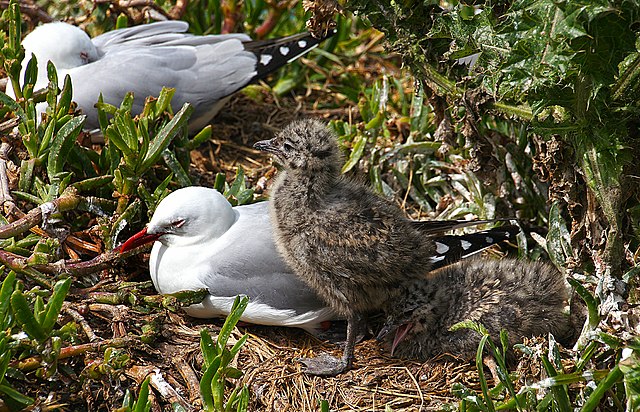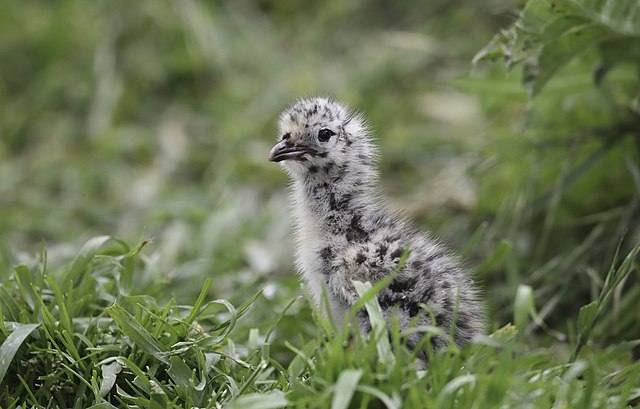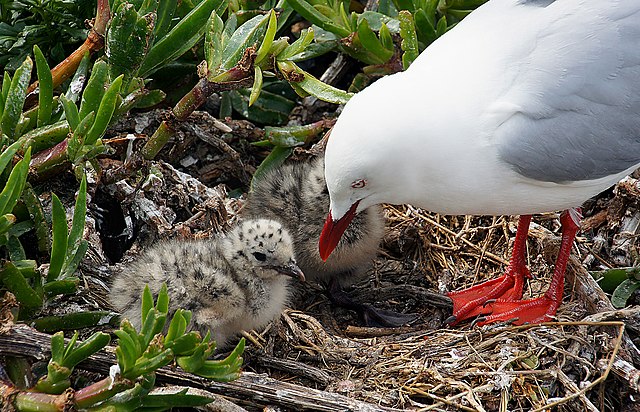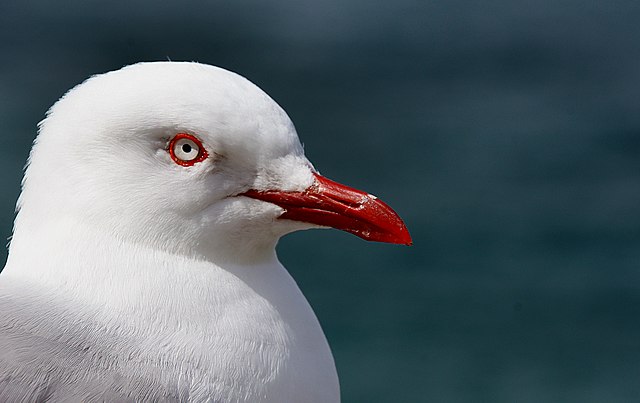If you park up at the beach with a feed of fish and chips it can seem like red-billed gulls are common and thriving. But 52 years’ worth of observations and monitoring data from New Zealand’s biggest gull breeding colony on the Kaikoura Peninsula tells a somewhat different story. Mammal predators are part of that story and so are tiny, high-protein sea creatures called euphausiids which are an important food source for raising chicks successfully.

Researchers, James Mills, John Yarrall, Janet Bradford-Grieve, Mike Morrissey and Deborah Mills look at the major changes occurring at the colony from a long-term study of the red-billed gull (Larus novaehollandiae scopulinus) population at the Kaikoura Peninsula. They review causes and consequences of population change in their article, recently published in Notornis, the research journal of NZ Birds (New Zealand Ornithological Society).
The Kaikoura breeding colony is now New Zealand’s largest – but that wasn’t always the case.
“Over the past 5 decades the red-billed gull population breeding at the Kaikoura Peninsula has undergone major changes. In the 1960’s, a survey of the locations and status of colonies in New Zealand and its outlying islands revealed that the Kaikoura population was the third largest in New Zealand. Since then, the 2 largest colonies (Three Kings Islands and Mokohinau Islands) have declined more than the Kaikoura colonies and as a result the Kaikoura breeding population is now the largest in New Zealand, even though between 1993 and 2003 the Kaikoura population declined by 51%.”

The breeding population is believed to have declined by 33% nationally, since a 1965 survey. Because of this, the red-billed gull is now classified as ‘At Risk – Declining’ under the New Zealand Threat Classification System.
“The red-billed gull population at Kaikoura has been banded for 58 years (1958–2015) and studied annually for 52 years (1964–2015). In all, over 70,000 nestlings have been banded, resulting in a large proportion of the population being of known age.”
“A total of 5,052 adults have been individually colour-marked, of which 3,386 were of known age. Each season re-sighting of these colour-marked individuals was used to determine the proportion that bred and the fate of the nesting attempt.”
There is little emigration of breeding adults, and virtually all offspring of breeding age return to the Kaikoura site to breed, making the Kaikoura population an ideal subject for study.
“Of the 9,086 male and 12,792 female recoveries, or re-sightings, of individually colour-marked gulls at Kaikoura during seasons from 1975 to 2000, 84% of males and 86% of females were re-sighted in subsequent seasons. Among those that were re-sighted, 96% of males and 93% of females were seen the following season, and only 2% of individuals were not seen within 2 seasons of their last sighting.”
In 1994 the population began to decline, and between 1983 and 2003 it dropped by 51%.
“Nests containing eggs of colour-marked individuals were marked each breeding season between 1965 and 2015, with a total of 23,933 nests marked. The fates of eggs and chicks were checked at least every 2 to 3 days, and chicks in the marked nests were generally banded within 4 days of hatching. Chicks that survived to 35 days of age were considered to be fledged.”
Fledging success varied markedly between breeding seasons. While cold weather, flooded nests and a lack of food at sea also had detrimental effects, the major cause of reproductive failure was predation by introduced mammals, especially ferrets and feral cats.
“Evidence of predation was confirmed either from the remains left at, or nearby, the nest, or from the disappearance of the nest contents. When possible, the predator responsible was determined by knowledge of the type of predator in the area from observations, scats, or dens, and the type of injury inflicted. However, in some cases it was not possible to identify the predator because eggs and chicks just disappeared from nests.”
The statistics make sombre reading.
“Over the 28 breeding seasons of the red-billed gull between 1964 and 1999 (September – January), a total of 1,455 prey items of stoats, 734 of ferrets and 273 of cats were identified adjacent to, or in, the dens. In the case of cats and ferrets, the list of items was incomplete because only 1 cat den and 3 dens of ferrets were located. On the Kaikoura Peninsula, these predators generally had dens in extensive, impenetrable flax groves. In addition, some cats appeared to range over a large area, making it difficult to locate dens. The number of eggs listed in the diet of all predators refers only to the numbers found in dens or caches and is therefore underestimated.”
So why did predators begin to have such a detrimental effect after 1994, when they have been present in New Zealand for so much longer?
“These predators became a problem when rabbits and hares increased in number, enhancing the predators’ survival over-winter. After 1987, rabbit and hare control by pest destruction agencies on the peninsula headland and adjacent farmland ceased, and the numbers of lagomorphs increased markedly. This increased the potential for cats and ferrets to survive over winter when the gulls had dispersed from Kaikoura.”
Predator control wasn’t carried out at all in the early years, but is now essential.
“For the first 11 years of the study (1964–74), the only mammalian predators present on the colonies were stoats, rats (Rattus rattus) and hedgehogs and there was no predator control. Thereafter Fenn traps were set in artificially constructed tunnels in an attempt to control stoats. From 2005, more intensive predator control, involving trapping and shooting, was initiated by the Department of Conservation to protect endangered Hutton’s shearwaters which were transferred to the peninsula to establish an alternative population.”

The impact of the arrival of cats and ferrets on the scene made a measurable difference to predation rates.
“Of the 23,933 nests monitored between 1964 and 2015, 44,759 eggs were laid in marked nests and 26.7% were lost to predation. Of the 22,119 eggs that hatched, 22.0% of the chicks were taken by predator. The extent of predation varied from season to season. When cats and ferrets arrived on the Kaikoura colonies in 1985, predation on eggs and chicks increased dramatically. For the 26 seasons that stoats were the main predator, egg losses averaged 20% and chick losses 15%. In comparison, for the 22 seasons when feral cats and ferrets were present for part or all of the red-billed gull breeding season, the loss of chicks and eggs was on average 15% higher.”
Adult birds are less vulnerable to predators than chicks and eggs, but not immune.
“Over the 53 years, 624 adult red-billed gulls and 447 adult white-fronted terns were known to be killed by either cats, stoats or ferrets. This is considerably fewer than the 11,966 eggs and 4,865 chicks taken from marked red-billed gull nests. For all mammalian predators, chicks and juveniles of red-billed gulls were the main prey items, making up 30% of the stoat diet, 43% for ferrets, and 53% for cats.”
Other factors impacting the gulls include food availability for growing chicks.
“At Kaikoura, the red-billed gull is dependent on a regular and abundant supply of euphausiids, Nyctiphanes australis (krill) for successful breeding. An increase in the availability of euphausiids appears to increase the likelihood of breeding, especially in young individuals, encourage earlier laying, improve the condition of adults, increase egg volume, clutch size and fledging success, all of which are fitness components. Nyctiphanes australis is restricted in distribution to coastal continental shelves in southeast Australia and New Zealand, optimally in 12-18°C water and becomes available to the gull when it swarms at the surface.”
Krill availability has been estimated annually from 1975 to 2015.
“When euphausiids are abundant, adults complete a foraging trip in approximately 2 hours but when scarce the trips take as long as 5-6 hours. Periodic failure in the availability of euphausiids, the main food of red-billed gulls, swamping of nests during high seas, and chilling of nestlings during long periods of bad weather also have been setbacks to the population. However, in the absence of predation, these factors produced only a temporary impact to the population of long-lived gulls.”
In some years, failure to breed has absolute.
“The peak in the numbers of pairs nesting on the Kaikoura Peninsula, since counts began in 1964, occurred in 1988, when 9,212 pairs nested. After 1991, the number of nests declined progressively until 2002. Thereafter the number of pairs nesting stabilized until 2015, fluctuating between 2,650 and 3,777 annually. Between 1965 and 2014, 17,630 nests were monitored, and on average 0.64 ± se 0.006 chicks were fledged annually per pair. Over the period, there were marked fluctuations in the fledging success. In 1987 and 1989, there were virtually no chicks fledged, and in 5 other seasons less than 0.33 chick per pair was produced.”
The long-term study also revealed 2 other important adverse trends.
“Firstly, the size of several morphological traits and body mass of both males and females has shown a statistically significant decline over the last 5 decades. Secondly, the annual survivorship of both sexes has declined. An analysis of 2,415 colour-marked individuals that were known to have died, or were assumed to have died, shows that males that survived initially to at least 2 years of age, had a mean life span of 12.9 years. In contrast, females lived an average of 2.9 years longer.
Because of the longer lifespan of females, there is a surplus of females in the Kaikoura population.
“The decline in both body size and survivorship of adults over the last 5 decades indicates that there are other factors at work and indicate that the population has experienced some form of unfavourable environmental condition or stress over a long period.”

Overall, the study over 52-year study shows that predation and fluctuations in the availability of euphausiids, the main food of the bird, are the most important influences on breeding success and population size. But in the future, climatic change could have a catastrophic effect on the birds’ ability to feed their chicks.
“For a species like the red-billed gull, which potentially lives to 32 years of age, with an average life span for adults of 12.9 years for males and 15.7 years for females, the occasional season when breeding success is low is not a serious problem. This applies to situations such as the periodic swamping of nests by extreme high tides and storms, and chilling of chicks during extended periods of bad weather and deaths from ticks, or even periodic drops in the food supply. Therefore, the bird could sustain periodic decreases in the availability of euphausiids in the absence of predation, but in the presence of high predation, fluctuations in the availability of food contribute to the decline. However, with the advent global climate change, it is envisaged that westerly winds over New Zealand will increase and this will affect the availability of euphausiids, and therefore the breeding success of the bird. If this occurs, it could affect the long-term viability of the Kaikoura red-billed gull population.”
Changes to the Kaikoura colony would affect gull numbers along a large stretch of New Zealand’s eastern coast.
“The Kaikoura population is a major source of red-billed gulls found along the eastern coast from Wellington to Timaru during autumn and winter. To maintain this traditional colony, it is imperative that more efficient control measures be developed to attract the predators to traps, or to poison predators, during and outside of the gulls’ breeding season. To reduce the number cats arriving on the peninsula where the gulls and terns nest, there needs to be a community effort, which could involve spaying and neutering domestic cats, and an awareness programme to prevent residents from releasing cats when they are no longer wanted. It would also help if the Kaikoura District Council would require members of the community to register, microchip, and apply a collar, to their cats so they can be identified as pets.”
The full research review is published in Notornis and freely available online.
Major changes in the red-billed gull (Larus novaehollandiae scopulinus) population at Kaikoura Peninsula, New Zealand; causes and consequences: a review (2018)

